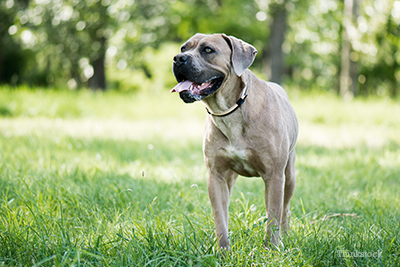Diskospondylitis refers to an infection within the back, specifically located within the disk and adjacent back bones (vertebrae). The disks are the cushiony structures located between adjacent vertebrae. When bacterial or fungal organisms manage to set up house within a disk and the vertebrae, on either side of it, the diagnosis is diskopondylitis. This disease can affect any dog, but large-breed, male dogs are most commonly affected. While any disk within the spine can become infected, those in the lower back (lumbosacral region) are the more common target location.
This disease can affect any dog, but large-breed, male dogs are most commonly affected. While any disk within the spine can become infected, those in the lower back (lumbosacral region) are the more common target location.
Cause
Bacterial infection is documented in the vast majority of cases. On rare occasion, fungal infection is identified. In many cases of diskospondylitis, the cause or source of the infection cannot be determined. In some dogs, infection within another part of the body such as the prostate gland or urinary bladder is discovered and thought to be the source of spread to the disk.
Symptoms
The symptom most dogs with diskospondylitis exhibit is substantial pain originating from the portion of the spine that is infected. If the infection is widespread, the spinal cord may be impacted, and neurological symptoms varying from mild incoordination all the way to paralysis may be present. Other commonly observed symptoms include:
Diagnosis
Diskospondylitis can sometimes be diagnosed with x-rays of the spine. In many cases, a CT or MRI scan is necessary to make the diagnosis and determine the true extent of the disease.
Other diagnostics are geared toward looking for the original source of infection, along with identifying the infectious organism that is causing the problem. This diagnostic testing (particularly advanced imaging of the spine) is usually best accomplished under the care of a veterinarian who specializes in surgery, neurology, internal medicine or radiology.
Diagnostic tests commonly included in a workup for diskospondylitis include:
- CBC (complete blood cell count)
- Blood chemistry profile
- Urinalysis
- Urine culture
- Blood culture
- Blood screening for fungal serology
- Chest x-rays
- Ultrasound evaluation of the heart
- Ultrasound evaluation of the abdomen
- Spinal fluid analysis and culture
- Screening for Brucellosis (a bacterial infection that is sexually transmitted)
Treatment
The mainstay of treatment for diskospondylitis is administration of long-term antibiotics or anti-fungal therapy, depending on the infectious organism identified. The antibiotic choice is ideally based on the results of bacterial identification and laboratory determination of its antibiotic sensitivity pattern.
When a bacterial infection is identified, antibiotics are administered for a minimum of eight weeks. Relapses are common if they are discontinued sooner. Antibiotics may initially be administered intravenously to rapidly achieve blood levels. Afterwards, the patient receives oral treatment at home.
Depending on the severity of symptoms, other treatments may be warranted including:
- Pain medication (narcotics and/or nonsteroidal anti-inflammatory medications)
- Intravenous fluids
- Close monitoring of heart rate, respiratory rate, body temperature
- Nursing care to prevent bed sores if the dog is unable to get up
- Rehabilitation therapy to restore normal strength and gait
In addition to monitoring how well the patient seems to feel, follow-up examinations may include repeating imaging studies, blood tests and bacterial cultures.
Prognosis
The outcome for diskospondylitis is variable and depends on the following factors:
- The severity of the infection
- The organism involved (fungal infections are more difficult to treat than bacterial infections
- How debilitated the patient is at the onset of treatment
- The ability of the caretaker to successfully support and treat their dog at home over the long haul
Questions for your veterinarian
- Do we know with certainty that my dog has diskospondylitis?
- Has an underlying source of infection been discovered?
- Do we know which infectious organism is present?
- What is the best course of treatment for my dog?
- How frequently should I bring my dog in to be reevaluated?
- Can you refer me to a specialist for a second opinion?
